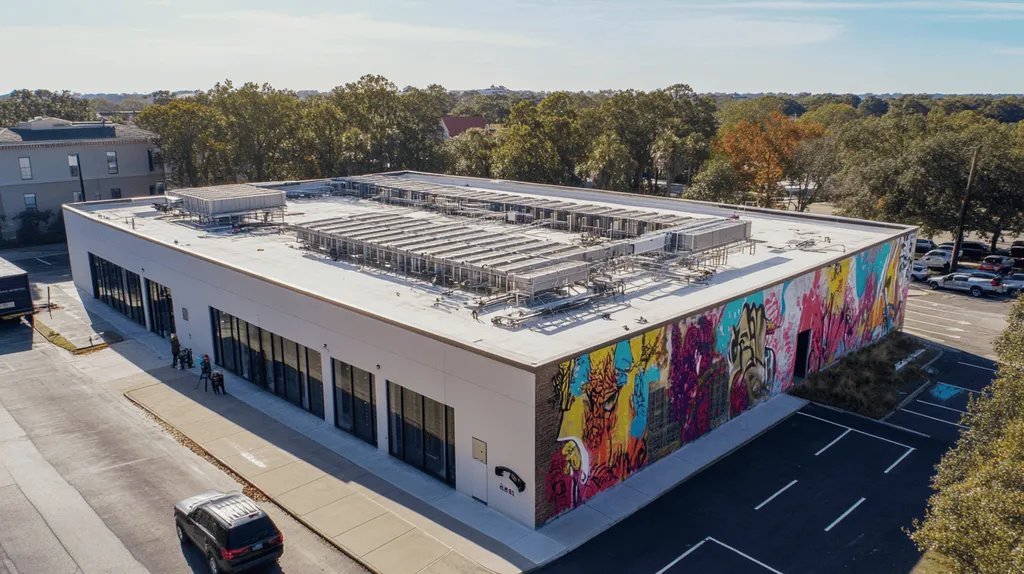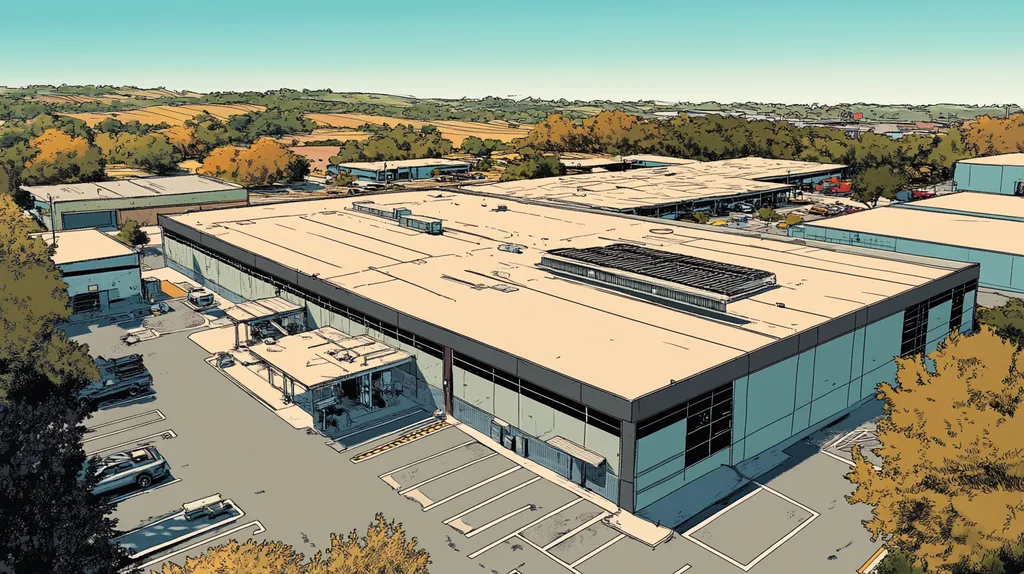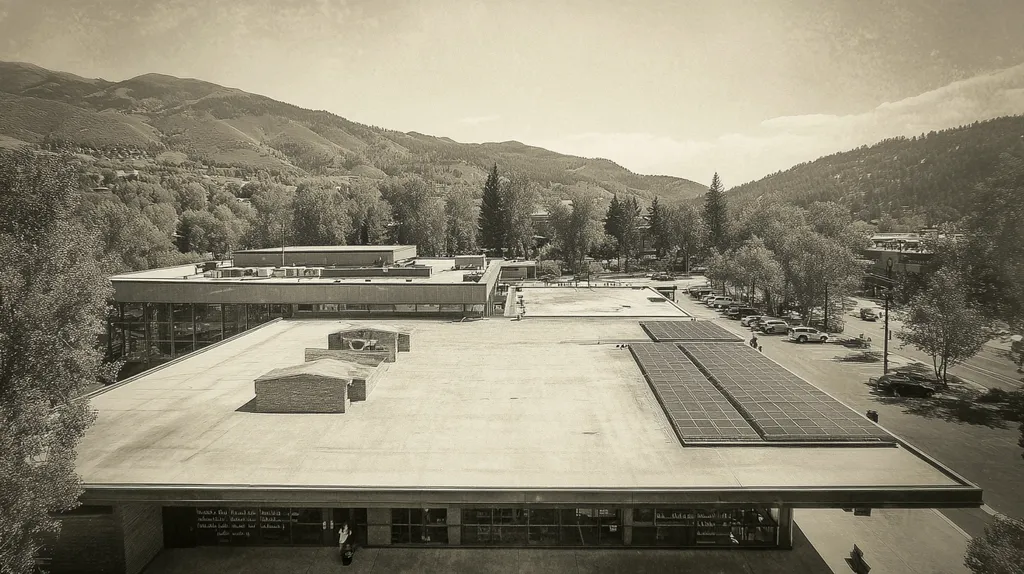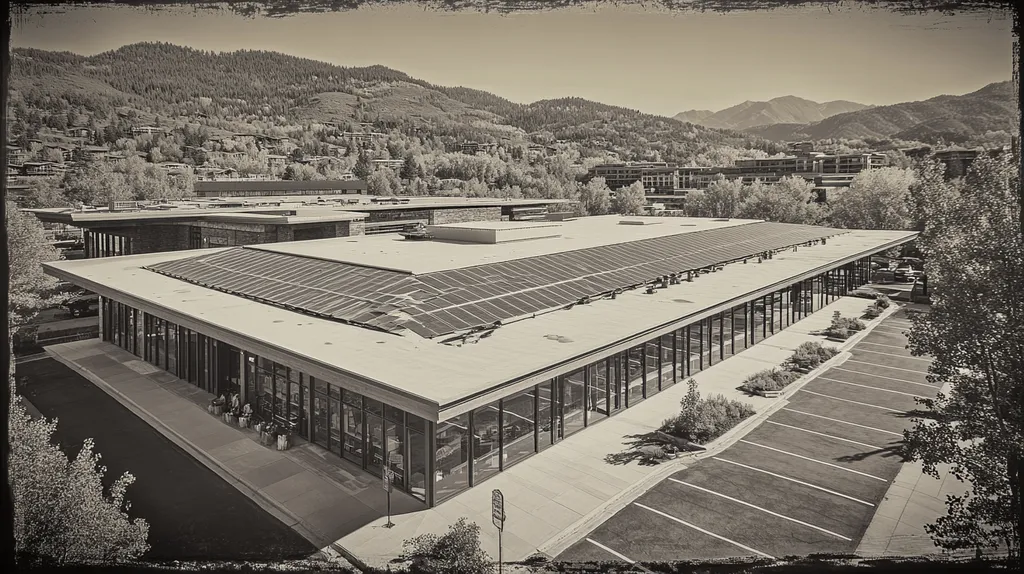Commercial building owners are facing unprecedented energy costs, with roofing inefficiencies accounting for up to 40% of cooling expenses in warm climates. The U.S. Department of Energy reports that reflective roof coatings can reduce peak cooling demand by 15-25%.
For facility managers seeking to control costs, roof coatings represent a critical opportunity to enhance energy performance while extending roof life. However, successful implementation requires careful attention to performance factors, financial considerations, and compliance requirements.
This guide provides property owners with actionable steps to evaluate, select, and maintain energy-efficient roof coating systems that deliver measurable returns on investment.
SECTION 1: PERFORMANCE FACTORS
In an era where energy costs are rising and sustainability is paramount, improving energy efficiency in commercial roofing has become a critical need. It is estimated that roofing inefficiencies can account for as much as 30% of a building’s total energy expenses. For property owners and facility managers, grasping the performance factors of roofing systems is essential for maximizing energy savings and extending the life of their investments. This section highlights three crucial areas: insulation effectiveness, surface reflectivity, and thermal conductivity.
Assessing Roof Insulation Effectiveness
Proper insulation is fundamental in preserving a building’s energy efficiency. A well-insulated roof significantly reduces heat transfer, helping maintain a comfortable interior temperature year-round. Regular inspections are essential to verify that insulation materials meet modern standards and performance requirements.
Insufficient insulation can lead to costly energy loss. For example, a typical flat roof without adequate insulation can result in increased heating expenses during the winter months. Facility managers must prioritize the use of high-quality, R-value-rated materials to enhance overall insulation performance.
Neglecting insulation issues can also result in moisture damage and other structural problems. A proactive strategy involves regular evaluations and necessary upgrades, especially for aging roofing systems.
Key Action Items
Evaluating Surface Reflectivity Levels
The energy performance of a building’s roof is greatly influenced by its surface reflectivity. Reflective roofing materials help minimize heat absorption, leading to lower cooling costs. Facility managers should measure their roofing materials’ Solar Reflectance Index (SRI) to gain insights into their energy efficiency.
For instance, white or light-colored roofing coatings can reflect up to 85% of sunlight, significantly cutting down cooling energy expenses, especially in hot climates. This is vital for locations where temperatures soar and cooling costs tend to escalate.
In contrast, darker roofing materials absorb more heat, increasing energy consumption and straining HVAC systems. It’s essential for owners to explore coating options that enhance reflectivity while maintaining the visual appeal of the structure.
Key Action Items
Measuring Thermal Conductivity
Thermal conductivity measures how well roofing materials transfer heat, affecting a building’s overall energy efficiency. Understanding this property is vital for reducing heat loss in winter and heat gain in summer.
Materials with low thermal conductivity can keep buildings comfortable regardless of outdoor temperatures, thus lowering energy expenses. For example, spray foam insulation can provide significant thermal performance improvements when applied to existing roofs.
Conversely, materials with high thermal conductivity can lead to fluctuating indoor temperatures and increased reliance on heating and cooling systems. Regular thermal evaluations can ensure roofing materials maintain optimal performance.
Key Action Items
SECTION 2: FINANCIAL CONSIDERATIONS
As energy costs continue to rise, commercial property owners and facility managers are under increasing pressure to elevate their buildings’ energy efficiency. Studies reveal that a reflective roof coating can reduce energy consumption by as much as 30%. Understanding the financial aspects of enhancing roof energy efficiency is essential for making informed decisions. This section delves into estimating energy savings, calculating return on investment (ROI), and comparing the costs of coatings versus roof replacement.
Estimating Energy Savings Potential
When evaluating roof coatings, understanding their impact on energy savings is crucial. Reflective coatings can drastically lower a building’s cooling costs by minimizing heat absorption. According to the U.S. Department of Energy, light-colored roofs can decrease surface temperatures by up to 70 degrees Fahrenheit.
To estimate potential energy savings, assess the building’s current energy consumption and apply the savings percentage associated with the coating. For example, if a commercial building incurs annual cooling costs of $10,000, implementing a suitable coating could save $3,000 each year.
Regional climate also influences energy savings potential. In warmer areas, the benefits of coatings become even more pronounced, making them an attractive option. Energy modeling tools can provide a more precise estimate, illustrating potential savings over time and reinforcing the financial merits of roof coatings.
Key Action Items
Calculating Return on Investment (ROI)
Understanding return on investment is essential when assessing roofing options. For roof coatings, ROI can be calculated by comparing total installation costs with anticipated long-term energy savings. To simplify, divide the annual savings by the initial investment in the coating.
For instance, if a reflective coating costs $15,000 and saves $3,000 annually, the ROI will become clear within five years. Importantly, many coatings last a decade or longer, leading to continued savings that amplify the overall return after the initial payback period.
Additionally, it is wise to include factors like reduced maintenance costs and prolonged roof lifespan in the ROI analysis. Coated roofs typically require fewer repairs, enhancing financial viability and cash flow, which can be reinvested into other building improvements.
Key Action Items
Comparing Cost of Coatings vs. Replacement
The costs associated with roof replacement often outweigh those for reflective coatings. A full roof replacement can range from $30,000 to $100,000, while a premium coating typically costs only $15,000 to $30,000.
When comparing these expenses, it’s crucial to consider long-term implications. Coatings can extend the life of the existing roof, delaying the need for an expensive replacement. This delay can translate to substantial savings when viewed over the years.
Property owners should also assess the potential business disruption during a roof replacement versus the quick application of a coating, which involves minimal downtime. This consideration adds further economic incentive to opt for coatings.
A comprehensive side-by-side cost analysis, factoring in savings from energy costs alongside the lower initial investment, highlights why coatings frequently emerge as the more cost-effective and operationally sound choice.
Key Action Items
SECTION 3: COMPLIANCE REQUIREMENTS
Compliance with roofing regulations is not merely a box to check; it’s essential for ensuring energy efficiency and avoiding financial pitfalls. Ignoring building codes, environmental regulations, and safety standards can lead to severe penalties, project delays, and even legal troubles. Research indicates that non-compliance could cost businesses up to 15% more over time due to inefficiencies. Therefore, property owners must stay vigilant in navigating these regulations to fully benefit from energy-efficient coatings.
Ensuring Compliance with Building Codes
Building codes set crucial safety and performance standards for roofs that must not be overlooked. Commercial property owners need to become familiar with both state and local codes that govern roofing materials and installation methods. Adhering to these codes ensures that coatings effectively reflect sunlight, leading to a reduction in energy consumption.
For example, many jurisdictions require roof coatings to have a designated solar reflective index (SRI) to be considered energy-efficient. Failure to comply with these codes can result in significant penalties, emphasizing the importance of being informed.
Using coatings that meet local building codes not only helps avoid penalties but can also enhance the building’s attractiveness in the market. Regularly consulting industry professionals ensures ongoing compliance with frequently updated building codes, making this front-end investment a safeguard against future costs.
Key Action Items
Meeting Local Environmental Regulations
Adhering to local environmental regulations is vital for minimizing the ecological footprint of commercial buildings. Many jurisdictions now mandate green certifications for roofs, particularly for those that utilize energy-efficient coatings. Non-compliance can lead to hefty fines or operational shutdowns.
For instance, several areas have requirements for using low-VOC (volatile organic compounds) materials in roofing systems to combat air pollution. Property owners must ensure that their chosen coatings meet these criteria, positively impacting public health.
Beyond compliance, following environmental regulations can boost a business’s reputation. Companies investing in sustainable roofing solutions often earn consumer trust and brand loyalty, making it a win-win situation. Additionally, there are potential grants and incentives available for meeting environmental standards, which can help offset the cost of implementing energy-efficient roofing systems.
Key Action Items
Adhering to Industry Safety Standards
Safety standards must be prioritized in any roofing project, especially during the application of coatings. Failing to adhere to these standards can lead to accidents and injuries, which jeopardize both personnel safety and project timelines.
Industry standards specify various safety protocols for roof installations, including proper training for workers and the use of personal protective equipment (PPE). Implementing these measures is crucial for preventing accidents and ensuring timely project completion.
Moreover, compliance with safety standards can positively impact insurance premiums. Companies that enforce robust safety measures often benefit from lower rates and fewer claims. Regularly updating safety practices and providing ongoing education to workers foster a culture of safety that ultimately benefits everyone involved in the roofing project.
Key Action Items
SECTION 4: RISK MANAGEMENT
For facility managers and property owners, the consequences of roof failure are incredibly serious. Each year, businesses incur billions in unexpected repair costs and wasted energy due to inefficient roofing systems. Without proper risk management, roofs can suffer from catastrophic leaks, structural failures, and inflated energy expenses. To avoid these costly setbacks, it’s essential to identify risks, prepare for weather-related damage, and establish a reliable emergency response plan.
Identifying Roof Failure Risks and Mitigants
Recognizing the risks that can lead to roof failure is key to effective commercial property management. Common issues include poor installation, natural wear and tear, and insufficient drainage systems, all of which can increase the likelihood of leaks and structural issues.
Evaluating the types of materials used and their expected lifespan helps pinpoint vulnerabilities in the roofing system. Roof coatings can act as valuable mitigants, adding a protective layer that enhances durability and extends the roof’s lifespan. Implementing a proactive maintenance schedule ultimately leads to reduced long-term costs.
Regular inspections should particularly target high-risk zones like seams and flashings. Spotting minor concerns early can prevent extensive repairs later on. For instance, a small leak may signal more significant underlying issues that require immediate attention.
Key Action Items
Assessing Weather-Related Damage
Weather-related damage is a primary concern that affects any commercial roofing system. Vulnerabilities to high winds, heavy rain, and snow can significantly impact energy efficiency and structural integrity. Conducting thorough assessments both before and after major weather events is crucial for ensuring safety and longevity.
After severe weather events, comprehensive post-storm inspections are essential. These checks help identify loose or damaged areas, preventing further deterioration. For example, a roof affected by hail may require immediate repairs to prevent water intrusion.
Applying weather-resistant coatings can improve a roof’s capacity to withstand harsh conditions. These coatings help reflect sunlight and reduce heat absorption, minimizing thermal expansion and contributing to a longer roof lifespan. Property managers must also monitor local weather patterns to inform their roofing strategies.
Key Action Items
Developing Emergency Response Plans
Not having a strategy for roofing emergencies can lead to complications and costly downtime. Every commercial property should have a strong emergency response plan in place for potential roofing issues. This plan is more than just a precaution; it’s a necessary strategy for effective property management.
Emergency plans must include clear response protocols detailing contacts and actions to take. A straightforward communication chain is essential for quick decision-making during emergencies. Ensuring that all staff are aware of these procedures is equally crucial for smooth operation.
Regular drills familiarize staff with the emergency protocols. For example, simulating a sudden roof leak can prepare teams to respond effectively in real-life scenarios. Incorporating preventative maintenance into the plan minimizes the chances of urgent repairs and enhances overall energy efficiency.
Key Action Items
SECTION 5: OPERATIONAL PROCEDURES
Improving energy efficiency in commercial buildings is an urgent priority. Rising energy costs and regulatory pressures compel property owners to act swiftly in optimizing their roofing systems. A carefully planned roof coating installation not only enhances energy efficiency but also extends the roof’s lifespan. Implementing effective operational procedures is crucial for the successful application and maintenance of roof coatings, significantly impacting a building’s total cost of ownership.
Preparing for Roof Coating Installation
Successful roof coating installation hinges on meticulous preparation. Property owners must ensure the existing roof is clean, dry, and free from debris or damage. This often involves thorough cleaning techniques, like power washing, to remove dirt and contaminants that could impair adhesion.
Inspecting the roof for existing issues is equally essential. Cracks, blisters, or leaks must be repaired before applying any coating. Early intervention not only secures a solid foundation for the coating but also helps prevent costly repairs in the future.
Selecting the correct coating for the roofing material is vital for optimal performance. Different roof surfaces may require specific coatings to achieve the best results. Consulting with roofing professionals can provide guidance on the products that will best address the unique requirements of each roof.
Moreover, timing is key. Installing coatings in extreme temperatures or bad weather can hinder adhesion, making it critical to schedule work carefully.
Key Action Items
Conducting Regular Maintenance Checks
Once a roof coating is applied, ongoing maintenance is crucial to preserving energy efficiency. Regular inspections should be planned at least twice a year to evaluate the coating’s integrity and identify any signs of wear.
Property managers must monitor the roof’s drainage systems to ensure they remain functioning and free from obstruction. Blockages can trap water, leading to damage of the coatings and potential leaks.
Maintaining organized records of all maintenance activities is essential for tracking the roof’s condition over time. This documentation can help identify potential issues early and guide future maintenance actions.
Ultimately, prompt minor repairs can avert larger damage down the road. Regular maintenance is not just about preservation; it’s essential for achieving maximum energy performance from the coated roof.
Key Action Items
Managing Staff Training and Awareness
Empowering staff through ongoing training is crucial for maintaining the performance of a coated roof. Knowledge of the roofing system’s specifics enables facility managers to make informed choices regarding maintenance and inspections.
Training sessions should emphasize the importance of roof coatings and their contribution to energy efficiency. Employees must learn to identify potential issues before they escalate, ensuring a proactive management approach.
Establishing clear guidelines for routine inspections and maintenance tasks can boost staff accountability. When every team member knows their responsibilities, it fosters a culture of care around building maintenance.
Finally, integrating energy efficiency goals into training can unify staff, highlighting the roof’s significance in overall building performance.
Key Action Items
SECTION 5: OPERATIONAL PROCEDURES
Enhancing energy efficiency in commercial buildings is more critical than ever. With climbing energy costs and regulatory pressures, property owners must act decisively to optimize their roofing systems. A thoughtfully planned coating installation can significantly improve energy efficiency while also extending the lifespan of the roof. Addressing operational procedures is vital to ensure the effective implementation and ongoing maintenance of roof coatings, which directly influence a building’s total cost of ownership.
Preparing for Roof Coating Installation
Effective roof coating installation begins with careful preparation. Property owners must guarantee that the existing roof is clean, dry, and free from debris or damage. This often involves thorough cleaning methods, such as power washing, to remove dirt and contaminants that could hinder adhesion.
Inspecting the roof for pre-existing issues is equally important. Cracks, blisters, and leaks should be addressed before any coating application. Tackling these problems upfront promotes a solid foundation for the coating and prevents costly repairs down the line.
Selecting the appropriate type of coating based on roofing material is crucial for optimal results. Different surfaces may require specialized coatings, so consulting with a roofing expert can provide valuable insights into the best products for each roof’s unique needs.
Lastly, choosing the right timing for installation is essential. Extreme temperatures or adverse weather can impair adhesion, emphasizing the need for careful scheduling.
Key Action Items
Conducting Regular Maintenance Checks
After applying a roof coating, ongoing maintenance is essential to maintain energy efficiency. Scheduling inspections at least twice a year is necessary to evaluate the coating’s integrity and detect any signs of wear.
Property managers should pay close attention to the roof’s drainage systems, ensuring they remain clear and fully operational. Blockages can cause standing water, damaging coatings and leading to potential leaks.
Keeping organized records of all maintenance activities is crucial for tracking the roof’s condition over time. This documentation can help pinpoint potential issues early and guide future maintenance efforts.
Additionally, addressing minor repairs promptly can prevent more extensive damage in the future. Regular upkeep is essential not only for preservation but also for maximizing energy performance from the coated roof.
Key Action Items
Managing Staff Training and Awareness
Investing in staff training is vital for maintaining the performance of a coated roof. A thorough understanding of the roofing system’s specifics enables facility managers to make informed decisions about maintenance and inspections.
Training sessions should emphasize the significance of maintaining roof coatings and their impact on energy efficiency. Employees must learn to recognize potential issues before they escalate, fostering a proactive management approach.
Establishing clear guidelines for routine inspections and maintenance tasks enhances team accountability. When team members understand their responsibilities, they contribute to a culture of care surrounding building maintenance.
Finally, incorporating energy efficiency targets into training can align staff efforts, reinforcing the roof’s critical role in overall building performance.
Key Action Items
The Bottom Line
Commercial buildings waste up to $30 billion annually on inefficient roofing systems, with energy losses accounting for 25-35% of cooling costs in warm climates.
Roof coatings represent a proven solution, delivering 15-25% energy savings while extending roof life by 10-15 years when properly maintained.
The data demonstrates that coating solutions outperform traditional roof replacements in both cost-effectiveness and energy efficiency, with ROI typically achieved within 3-5 years.
As energy costs continue rising and environmental regulations tighten, property owners who delay implementing coating solutions risk falling behind competitors while paying increasingly higher operating expenses.
The time for enhancing roof energy efficiency through coating systems is now – before rising costs and stricter regulations force reactive rather than strategic decisions.
FREQUENTLY ASKED QUESTIONS
Q. What performance factors affect a commercial roof’s energy efficiency?
A. Key performance factors include insulation effectiveness, surface reflectivity, and thermal conductivity. Proper insulation minimizes heat transfer, while reflective surfaces help lower cooling costs. Understanding these factors boosts energy savings and prolongs the roof’s lifespan.
Q. How can a commercial roof coating impact financial savings?
A. A reflective roof coating can significantly reduce cooling costs, potentially saving up to 30% annually. Property owners should evaluate energy expenses and consider return on investment to understand the savings benefits of coating options versus replacements.
Q. What are the compliance requirements for commercial roofs?
A. Property owners must adhere to local building codes, environmental regulations, and safety standards. Compliance ensures energy efficiency and helps avoid fines. Regular consultations with roofing professionals can aid in maintaining compliance with updated regulations.
Q. How can I manage risks related to my industrial roof?
A. Identifying risks involves evaluating installation quality, natural wear, and drainage issues. Implementing a preventive maintenance schedule and applying protective coatings can mitigate potential failures, ensuring continuous roof integrity and performance.
Q. What operational procedures ensure effective roof coating application?
A. Effective procedures include thorough roof cleaning, inspecting for damage, choosing the right coating, and scheduling installation during favorable weather conditions. These steps secure better adhesion and longevity of the roof coating.
Q. Why is staff training vital for maintaining a commercial roof?
A. Ongoing training empowers staff to recognize potential issues promptly and ensures adherence to maintenance protocols. Educating employees on the importance of roof coatings promotes proactive management and enhances a building’s overall energy efficiency.
Q. What additional features can enhance a commercial roof?
A. Incorporating green roofing options, such as vegetation or solar panels, can significantly enhance energy efficiency and sustainability. Additionally, investing in durable, weather-resistant materials can improve longevity and reduce maintenance expenses over time.











